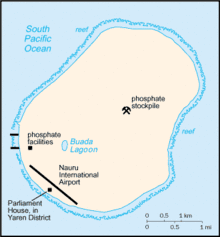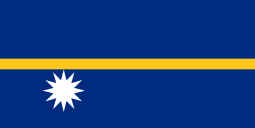Economy of Nauru
The economy of Nauru is tiny, based on a population in 2014 of only 11,000 people.[6] The economy is primarily based on phosphate mining, offshore banking, and processing of coconut products. Mining of phosphate ceased after the exhaustion of the primary phosphate reserves, but in 2006–07 mining of a deeper layer of "secondary phosphate" began. It is hoped that this economic activity might lift Nauru from the bottom rung of global GDP per capita. The only other major source of government revenue is sale of fishing rights in Nauru's territorial waters.
.jpg) | |
| Currency | Australian dollar (A$ or AUD) |
|---|---|
| 1 July – 30 June | |
Country group |
|
| Statistics | |
| Population | |
| GDP | |
| GDP rank | 192nd (nominal) / 195th (PPP) |
GDP growth |
|
GDP per capita | |
GDP by sector | Agriculture: 6.1%, industry: 33%, services: 60.8% (2009 est.) |
| 0.463% (2018 est.)[4] | |
| Unemployment | 23% (2011)[5] |
Main industries | Phosphate mining, offshore banking, coconut products |
| External | |
| Exports | $47.5 million (2013)[6] |
Export goods | Phosphate, coconut products |
Main export partners | India, New Zealand, South Korea, Australia |
| Imports | $143.3 million (2013)[6] |
Import goods | Food, fuel, manufactures, building materials, machinery |
Main import partners | Australia, Fiji, Japan, China |
| Public finances | |
| $33.3 million (2004 est.) | |
| Revenues | $58.3 million (2012–2013)[6] |
| Expenses | $57.9 million (2012–2013)[6] |

Nauru is dependent on foreign aid, chiefly from Australia, Taiwan and New Zealand.
Economic performance
In the years after independence in 1968, Nauru possessed the highest GDP per capita in the world due to its rich phosphate deposits. In anticipation of the exhaustion of its phosphate deposits, substantial amounts of the income from phosphates were invested in trust funds aimed to help cushion the transition and provide for Nauru's economic future. However, because of heavy spending from the trust funds, including some wasteful foreign investment activities, the government is now facing virtual bankruptcy. To cut costs the government has called for a freeze on wages, a reduction of over-staffed public service departments, privatization of numerous government agencies, and closure of some of Nauru's overseas consulates. Economic uncertainty caused by financial mismanagement and corruption, combined with shortages of basic goods, has resulted in some domestic unrest. In 2004 Nauru was faced with chaos amid political strife and the collapse of the island's telecommunications system. Moreover, the deterioration of housing and hospitals has continued.
Few comprehensive statistics on the Nauru economy exist, with estimates of Nauru's GDP varying widely. According to the U.S. State Department, Nauru's GDP volume was US$1 million in 2004. Nauru receives about US$20 million foreign aid a year from Australia.[7]
The nations economy has grown significantly since 2012, with help from the reopening of the Nauru Regional Processing Centre, located in Australia.[8]
The most recent 2017/2018 Nauru Budget indicates modest economic growth, with $128.7 million in revenues and $128.6 million in expenditures estimated.[9]
Balance of payments
Phosphate is Nauru's only export product, although the government also receives relatively significant foreign exchange income from licensing its rich skipjack tuna fishing grounds to foreign fishing vessels, which land an annual average of 50,000 tonnes of Nauru zone-caught tuna overseas.[10] In 2004 income from phosphate export was US$640,000, with Australia, New Zealand and Japan serving as the country's major export markets. In the same year the Nauru government budget shows that income from licensing foreign fishing vessels was over US$3,000,000.
Nauru needs to import almost all basic and capital goods, including food, water, fuel, and manufactured goods, with Australia and New Zealand as its major import sources. In 2004 Nauru's imports totaled about US$19.8 million.[7]
Finance
Nauru has been a cash economy since at least 2004, after the Bank of Nauru and the Republic of Nauru Finance Corporation went bankrupt and ceased operations in the early 2000s and the licenses of all offshore banks were revoked by the Nauru government in 2004.[11] Nauru uses the Australian dollar for its currency. Deposit-taking institutions do not exist on the island, and community savings are required to be held in the form of cash, and all transactions are conducted using cash. The government is required to periodically fly in Australian currency to maintain liquidity.
The Australian government shut down Nauru's banking system in 2006. Nauru's government has been talking with Bendigo & Adelaide Bank Ltd., Australia's fifth-largest lender, to set up a branch on the island[12] and move to a system where the entire population uses a bank.[13] Effective from the end of April 2016, Westpac, one of Australia's largest banks, ceased having any dealings with the Nauru government.[14] On 21 April 2016, it was announced that the Bendigo Bank was facing pressure to also close its operation in Nauru.[15] There are indications that the Australian banks have legal problems in Australia over efforts to combat money laundering.
Taxation
On October 1, 2014, an income tax was imposed in Nauru for the first time, with high income earners paying a flat rate of 10%. The government spending in 2015 was forecast to be under US$92 million.[16] Taxes include an airport departure tax and a bed tax at the Meneñ Hotel. The 2007–08 Budget saw the increase of existing excises on cigarettes and duty on imports. A tax on sugary foods was also introduced, chiefly to help combat Nauru's diabetes epidemic.[17]
Tax haven status
Historically Nauru was regarded as a tax haven due to the operation of its international financial centre, which offered amongst other things offshore banking services.[18] In 2001, Nauru was blacklisted internationally over concerns it had become a haven for money laundering.[13] Amendments made in 2004 abolished Nauru's Offshore Banking sector and, as recognised in Nauru's latest anti money laundering and countering the financing of terrorism (AML/CFT) review, Nauru's offshore sector is now limited to a small offshore company register.[19]
In July 2017 the Organisation for Economic Co-operation and Development (OECD) upgraded its rating of Nauru's standards of tax transparency. Nauru had been listed alongside fourteen other countries that had failed to show that they could comply with international tax transparency standards and regulations. The OECD subsequently put Nauru through a fast-tracked compliance process and the country was given a "largely compliant" rating.[20]
Relationship with Australia
Currently, Nauru is heavily dependent on Australia as its major source of financial support. In 2001 Nauru signed an agreement with Australia to accommodate asylum seekers (mostly from Iraq and Afghanistan) on the island, in return for millions of dollars in aid. This agreement, referred to as the "Pacific Solution", came to an end in 2007, prompting Nauruan concerns about the future of the island's revenue.[21] Australia has also sent financial experts to Nauru to help the tiny nation overcome its economic problems. However, serious questions remain about the long-term viability of Nauru's economy, with uncertainties about the rehabilitation of mined land and the replacement of income from phosphates.[7]
In 2008, talks began between Australia and Nauru regarding the future of the former's economic development aid to the latter. Nauruan Foreign and Finance Minister Dr. Kieren Keke stated that his country did not want aid handouts. One possible solution currently being explored would be for Australia to assist Nauru in setting up a "boat repair industry" for regional fishing vessels.[22]
Nauru detention centre
The Nauru detention centre was established by the Australian government, with Nauruan agreement, in 2001 to cater for up to 800 refugees and asylum seekers under Australia's Pacific solution. The centre is seen by Nauruans as an important source of employment opportunities, in addition to the pledge of A$20 million for development activities.
Economic statistics
- GDP: purchasing power parity - US$60 million (2001 est.)
- GDP per capita: purchasing power parity - US$5,000 (2001 est.)
- Inflation rate (consumer prices): -3.6% (1993)
- Budget: revenues: US$23.4 million; expenditures: US$ million (1995/96)
- External debt: US$33.3 million
- Economic aid - receives around US$2.25 million from Australia (1996/97 est.)
- Currency: Australian dollar
The fiscal year runs from July 1 to June 30.
Employment
- Labour force are mainly employed in mining phosphates, public administration by RONPhos, education and transport
- In 2004, the Unemployment rate was close to 90%.[23] In February 2008, foreign affairs minister Dr. Kieren Keke stated: "We have got a major unemployment crisis in front of us."[24]
- Main industries are phosphate mining, offshore banking, coconut products
- Electricity production (fossil fuels) and consumption are around 30 GWh (2000)
- Agriculture is not a major employer, coconuts are the main produce
Trade
- Exports - valued at US$25.3 million (1991), mainly phosphates, main partners are New Zealand, Australia, South Korea, US (2000)
- Imports - valued at US$21.1 million (1991), mainly food, fuel, manufactures, building materials, machinery, main partners are Australia, United States, UK, Indonesia, India
See also
- Phosphate mining in Nauru
- Nauru Phosphate Corporation
- Nauru Phosphate Royalties Trust
- Tourism in Nauru
References
- "World Economic Outlook Database, April 2019". IMF.org. International Monetary Fund. Retrieved 29 September 2019.
- "World Bank Country and Lending Groups". datahelpdesk.worldbank.org. World Bank. Retrieved 29 September 2019.
- "Population, total - Nauru". data.worldbank.org. World Bank. Retrieved 2 April 2020.
- "World Economic Outlook Database, October 2019". IMF.org. International Monetary Fund. Retrieved 20 October 2019.
- "Pacific Regional Statistics - Secretariat of the Pacific Community". www.spc.int.
- "Nauru Statistics". nauru.prism.spc.int.
- "CountryWatch - Login Page".
- Asian Development Bank (2014). Pacific Economic Monitor: Budget Analysis. Manila: Cornell University School of Industrial and Labor Relations. p. 8.
- "Modest economic growth forecast for Nauru - Loop Nauru". 12 June 2017.
- Nauru Fisheries and Marine Resources Authority. "NFMRA Corporate Plan". Government of Nauru. Retrieved 2018-03-13.
- "Sectors - Commonwealth of Nations".
- Flitton, Daniel (26 March 2014). "'Uncertainties' lead to Australian bank dumping plans for Nauru's only branch". The Sydney Morning Herald.
- "Tiny Island Nation Of Nauru To Rebuild Its Banking System With Help From Australia". 4 November 2013.
- "Westpac bank to exit Nauru". 14 April 2016.
- "Bendigo Bank facing pressure to close its operation in Nauru". 21 April 2016.
- "Income taxes coming in Nauru", Radio New Zealand International, 11 June 2014
- "CountryWatch - Login Page".
- https://www.fas.org/sgp/crs/misc/R40623.pdf
- "Asia / Pacific Group On Money Laundering". www.apgml.org.
- "Nauru gets an OECD upgrade". 12 July 2017.
- "Nauru 'hit' by detention centre closure", The Age, February 7, 2008
- "Nauru suggests boat repair industry" Archived 2008-05-28 at the Wayback Machine, Saipan Tribune, March 4, 2008
- CIA - The World Factbook - Nauru Archived 2014-07-23 at the Wayback Machine
- "Nauru 'hit' by detention centre closure". The Age. February 7, 2008.
External links
- "Nauru seeks to regain lost fortunes", Nick Squires, BBC, March 15, 2008
- "Nauru's riches to rags decline", Dan Nolan, Al Jazeera, March 17, 2008
